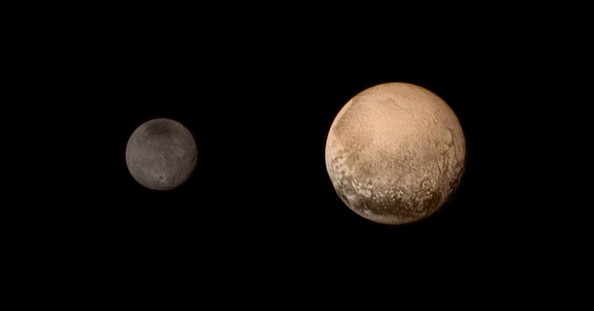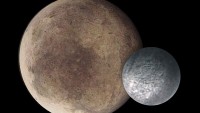Pluto Flyby UPDATE: Can New Horizons Spacecraft Accomplish Mission To Pluto, Charon?
| KJ Belonio | | Jul 14, 2015 06:45 AM EDT |
(Photo : Getty Images/NASA) The core science mission of the New Horizons is to map the surfaces of Pluto and Charon. The mission also aims to study Pluto’s atmosphere and to document its temperature readings.
Pluto Flyby Update - After 9 years and 3 billion miles, Earth will finally have a glimpse of its far-flung cosmic cousin. While so many questions are still left unanswered about the solar system, NASA's New Horizons spacecraft will gather some data and explore the enigmatic dwarf planet Pluto and its surroundings.
Like Us on Facebook
As NASA's New Horizons spacecraft sails towards Pluto, its daring rendezvous will be guided by the light of the stars. According to Phenomena, navigating by starlight is a tried-and-tested way to navigate across the vast cosmic seas of the solar system. Starlight is also helpful in telling the spacecraft where to point its instrument when it finally meets Pluto.
Moreover, there are 7 science instruments aboard the New Horizons spacecraft and two of them are star cameras, aimed in different direction. The cameras take photos of the starfields 10 times per second. Then, those images will be compared to an onboard map of over 10,000 stars, which will tell the spacecraft if it's tipped up or down, or slightly swiveled.
"They're used for determining which direction the spacecraft is pointed in, or where all the cameras and instruments are oriented," New Horizons' lead guidance and control engineer Gabe Rogers said.
So, can NASA's New Horizons spacecraft accomplish the daring Pluto flyby mission? Space experts and space enthusiasts alike are definitely excited as the baby grand piano-sized New Horizons spacecraft makes its closest approach to the dwarf planet on July 14. Experts are practically ecstatic as the flyby will give them more detailed and far-superior images of this elusive and diminutive celestial object.
The solar system presents a vast scientific wonderland and Pluto proves to be one of the most fascinating cosmic entity. And as its surface features are about to be revealed, scientists will soon begin to understand its atmosphere, its moons and how the solar system's history evolved.
Since New Horizons carried out its journey, the mission targets to complete NASA's reconnaissance of the classical solar system. And by learning more about these icy bodies, scientists could determine the cosmic history of the solar system as well as how planets are formed and how dwarf worlds like Pluto evolved, Mashable noted.
The core science mission of the New Horizons is to map the surfaces of Pluto and Charon. The mission also aims to study Pluto's atmosphere and to document its temperature readings, CNN reported.
"We're just learning that a lot of planets are small planets, and we didn't know that before," mission's principal investigator Alan Stern said. "Fact is, in planetary science, objects such as Pluto and the other dwarf planets in the Kuiper Belt are considered planets and called planets in everyday discourse in scientific meetings."
Meanwhile, the probe will neither orbit nor land on Pluto. Instead, it will navigate deeper into the Kuiper Belt, a region filled with hundreds of small, icy objects, as scientists believed.
TagsPluto Flyby, new horizons spacecraft, New Horizons, Pluto, Charon, NASA, outer space
©2015 Chinatopix All rights reserved. Do not reproduce without permission
EDITOR'S PICKS
-

Did the Trump administration just announce plans for a trade war with ‘hostile’ China and Russia?
-

US Senate passes Taiwan travel bill slammed by China
-

As Yan Sihong’s family grieves, here are other Chinese students who went missing abroad. Some have never been found
-

Beijing blasts Western critics who ‘smear China’ with the term sharp power
-

China Envoy Seeks to Defuse Tensions With U.S. as a Trade War Brews
-

Singapore's Deputy PM Provides Bitcoin Vote of Confidence Amid China's Blanket Bans
-

China warns investors over risks in overseas virtual currency trading
-

Chinese government most trustworthy: survey
-

Kashima Antlers On Course For Back-To-Back Titles
MOST POPULAR
LATEST NEWS
Zhou Yongkang: China's Former Security Chief Sentenced to Life in Prison

China's former Chief of the Ministry of Public Security, Zhou Yongkang, has been given a life sentence after he was found guilty of abusing his office, bribery and deliberately ... Full Article
TRENDING STORY

China Pork Prices Expected to Stabilize As The Supplies Recover

Elephone P9000 Smartphone is now on Sale on Amazon India

There's a Big Chance Cliffhangers Won't Still Be Resolved When Grey's Anatomy Season 13 Returns

Supreme Court Ruled on Samsung vs Apple Dispute for Patent Infringement

Microsoft Surface Pro 5 Rumors and Release Date: What is the Latest?












